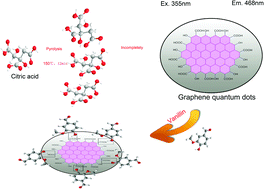One-step synthesis of fluorescent graphene quantum dots as an effective fluorescence probe for vanillin detection
Abstract
This study proposes an easy bottom-up method for the synthesis of photoluminescent (PL) graphene quantum dots (GQDs) using citric acid as the carbon source. The obtained GQDs were characterized by high-resolution transmission electron microscopy (HRTEM), UV-vis absorption spectroscopy, fluorescence spectroscopy, and Fourier transform infrared spectroscopy (FT-IR). The synthesised GQDs have an average diameter of 4.76 ± 0.96 nm, with a lattice spacing of 0.24 nm. The GQDs exhibit excitation-independent PL emission. The surface of the GQDs has a variety of functional groups (hydroxyl, carboxyl, and ether groups etc.) to enhance its stability and water solubility. In this study, a fluorescent “on–off” sensor is developed for the selective detection of vanillin in chocolates using GQDs as a fluorescent probe. Under optimal conditions, fluorescence intensity of the GQDs has a good linear relationship with the vanillin concentration (0.0–2.1 × 10−5 mol L−1), with a limit of detection of 2.5 × 10−8 mol L−1. For detection in real samples, the percent recovery of vanillin and the relative standard deviation were 88.0–108.9% and 0.90–5.4%, respectively. Thus, this GQDs-based method has good accuracy and precision and can be used for vanillin detection in practical applications.



 Please wait while we load your content...
Please wait while we load your content...